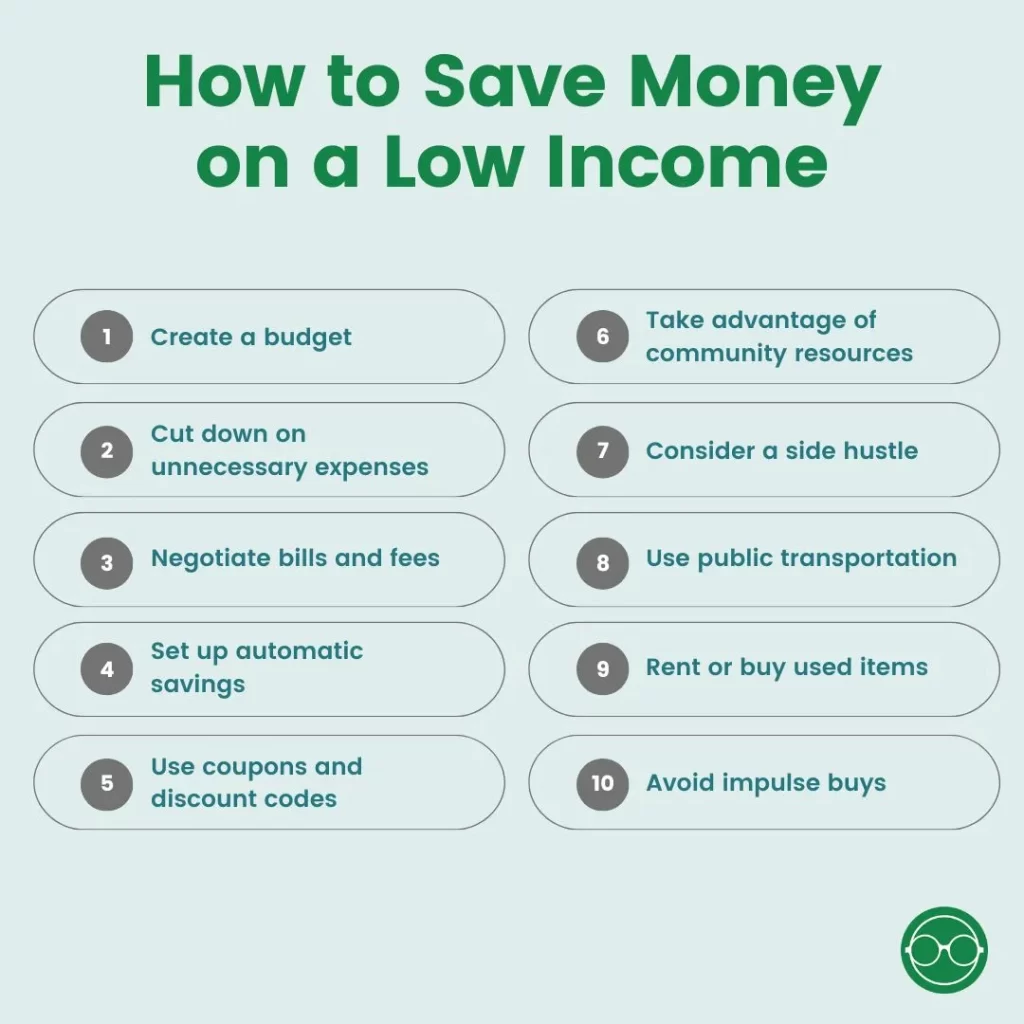This post may contain affiliate links. We may receive compensation when you click on links to those products at no additional cost to you. Read our full disclosure here.
Living on a low income can make saving money seem impossible. However, with the right mindset and strategies, you can still save money, take control of your finances, and reach your financial goals.
Here are some tips and tricks I’ve compiled to help you save money on a low income.

1. Create a Budget
Fact: EVERYONE needs a budget no matter how much money you make. Knowing where your money is coming from and going to is foundational and the first step to helping you save money on a low income.
Here’s what you can do:
- Choose how you want to create and track your budget.
- Budgeting apps like Mint, Empower Capital, and RocketMoney
- If you prefer a more manual way, budgeting spreadsheets are great as well especially if you want more customization.
- On your preferred budget maker, list out all your income.
- List out all your expenses.
- If you’re using budgeting apps, they may automatically pull the past 90 days of transactions for you. Your job now is to categorize those transactions and set your ideal spending budget for each category.
- If you’re doing it manually, you can export the monthly statements from your bank and credit card accounts for the past 3 months in a .csv file and then paste them into your budgeting spreadsheet.
- If your income is more than expenses, plan to save the rest!
- If your expenses are more than your income, you’ll need to make adjustments by:
- Increasing your income (Read more about the different ways here)
- Decreasing your expenses. Look at your budget and see where you can cut back.
Curious to learn more about a budget? Read more here.
2. Cut Back on Unnecessary Expenses
Once you have a clear idea of where your money is going, it’s time to look for areas where you can cut back.
For example, if you’re spending a lot on eating out, try cooking at home more often. If you’re paying for a gym membership you don’t use, cancel it and try exercising at home or outside. Every little bit counts, so be creative and look for ways to save on your expenses.
Some of my favorite ways to decrease expenses include:
- Cheaper phone plan: Most people don’t need unlimited data, especially with Wifi access everywhere.
- Shop smart: When shopping for groceries and household items, buy in bulk and choose generic or store-brand items to save money over time. Also, try to shop at discount stores or use online shopping to find the best deals.
- Plan your meals: Planning your meals in advance can help you save money and avoid eating out. Make a grocery list and stick to it, and plan meals around ingredients that are on sale or in season.
- Find free entertainment: I’m all about enjoying life through entertainment, and thankfully there are many free or low-cost options available:
- You can check out your local library for books, movies, and other media.
- Look for free events in your community, such as concerts or festivals.
- You can also enjoy the outdoors by hiking or visiting a park.
3. Negotiate Bills and Fees
When it comes to bills and fees, don’t be afraid to negotiate. Call your service providers and ask if they can offer you a better rate or plan. You can also negotiate medical bills, insurance payments, or credit card fees. Every little bit counts, and you may be surprised at how much you can save by negotiating.
The main takeaway I want you to have is that “it never hurts to ask“!
Besides, there is even an app called Rocket Money that can help you:
- Cancel unused subscriptions
- Get in contact with service providers like your Internet provider to negotiate your bill down.
- You only pay Rocket Money a percentage of the amount they saved you! So if they didn’t save you anything, you don’t pay anything.
Just remember to save any new savings from negotiated bills and fees!
4. Set Up Automatic Savings
One of the best ways to save money on a low income is to set up automatic savings. The key is to treat savings like a recurring expense, whereby you set up automatic transfers from your checking account to your savings account every month, no questions asked.
You’ll need a budget to execute this so that you can add “savings” as a line item for your expenses. This way, you can also see if you need to cut down on certain expenses to ensure that you have enough to save.
Even if you can only save a small amount each month, it will add up over time and help you reach your financial goals.
5. Use Coupons and Discount Codes
Coupons and discount codes can help you save money on a low income, especially on groceries and other essentials. Check online for coupons and promo codes before you make any purchases.
I currently use Microsoft Edge for my browser and it has a pretty neat “Shopping” tool that automatically detects any coupons for the site and also tracks any price changes for the past 90 days or so.

You can also sign up for loyalty programs and email lists to get access to exclusive deals and discounts.
6. Take Advantage of Community Resources
Many communities offer resources and programs to help low-income individuals and families. For example, you can check with your local food bank for free or low-cost groceries, or a non-profit for living expenses assistance. Don’t be afraid to ask for help when you need it.
UnitedWay has a free service that helps people across the U.S. and Canada find the local resources they need. These local resources can either help by providing you with some monetary assistance or help you manage your bills to save money on a low income.
- All you need to do is dial 2-1-1 and someone should be available to help you 24/7.
7. Consider a Side Hustle
If you’ve really exhausted your options in the sense of decreasing expenses, consider starting a side hustle to increase your income so that you can have more discretionary income to save.
There are many ways to make extra money, from blogging, freelance writing, and graphic design to pet-sitting and house-cleaning. Look for opportunities that fit your skills and interests, and start earning extra cash today.
I wrote more about the different ways to make extra money here so be sure to check it out to learn more!
8. Use Public Transportation
If you don’t have a car, or if you’re trying to save money on transportation, consider using public transportation. Many cities offer affordable options such as buses and trains. You can also consider biking or walking if it’s a viable option for you.
Try not to purchase a car with a loan if you don’t need it as the monthly payments can put a dent in your savings plan to save money on a low income.
If you really need a car to get to work and want to figure out affordability, here’s a more in-depth article about whether you can afford a car or not.
9. Consider Renting or Buying Used Items
When you need to buy something, consider renting or buying used items instead of buying brand-new ones. You can also rent items such as tools or equipment instead of buying them outright.
Try to look for second-hand stores or online marketplaces where you can find gently used items at a fraction of the cost. Facebook Marketplace is probably a fan favorite, but be sure to verify the seller so that you do not get scammed. (Read more here for some tips)
10. Avoid Impulse Buys
Impulse buys can quickly add up and derail your plan to save money on a low income. Here are a few tips to avoid impulse buys:
- Before making a purchase, ask yourself if you really need it.
- Ask yourself if it fits into your budget.
- Consider waiting a few days before making the purchase to avoid impulse buys.
- Consider the opportunity cost of buying the item (ie. what if you invested the amount instead?)
Final Thoughts
Trying to save money on a low income can be challenging, but it’s important to stay motivated. Keep your goals in mind and remind yourself why you’re saving money.
Celebrate your successes, no matter how small they may seem. And remember every little bit counts, so keep looking for ways to save and improve your financial situation.
This post may contain affiliate links. We may receive compensation when you click on links to those products at no additional cost to you. Read our full disclosure here.






